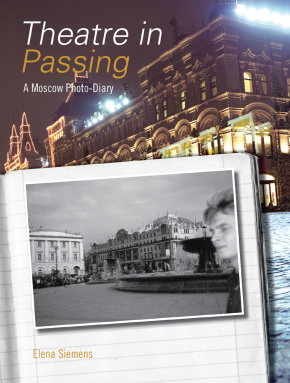Elena Siemens, Theatre in Passing. A Moscow Photo-Diary (2011) and Theatre in Passing 2. Searching for New Amsterdam (2015). Intellect, Bristol and University of Chicago Press, Chicago.
‘It “began with street talk and racy doggerel and ended up with the future of Christ” (Shklovsky 1991:171).’ (Blok 1980 cited in Siemens 2011:206)
Theatre in Passing is presented as a ‘theatrical geography’ of the spaces of performance, both everyday and artistic, in the city. Taking Moscow (in the first volume) and a wider set of cities (in the second), Elena Siemens weaves memory into an urban texture. This is more than a text and distinct from creating an actual object such as a montage. She draws together an intellectual geography, memory, history and cultural theory (de Certeau, Blok, Barthes, Benjamin, Boym) anchored to places by black and white photos. Her subjects include signage, monuments, facades and oblique views across streets, parks and entrances. She rarely comments on technique but this photo diary reflects on the importance of images to the city and urban life. A photo diary is not only a long-running personal project but a trope that centres the author-photography-narrator’s body as a walker or flâneur.

The meaning of the images arises out of the tension of relations and memories discussed in the text. This is not captioning but a form of pinning and capturing text in place. Drawing on de Certeau’s insight that the walker has a view of urban process that is as privileged as the ‘voyeurs’ or planners aerial view from above, in these volumes there are no maps, no bird’s-eye views: the book serves as a virtual labyrinth that stands in for and demonstrates how the images relate to actual places. Siemens comments on her image making in a way that builds up a sense of her engagement with the city and its spaces.
‘On a more recent trip to Moscow, I saw a much larger version of the same Adidas banner stretched over Tverskaya Street. I took a better picture, which I later discarded.’
This use of a multilayered past tense to engage the contemporary city of the present is key to bringing memory and history into the present and to reinforcing the way that images, the lightest of cultural objects, can anchor memory to the ground of the city. These books are ‘weapons… set against the enemy’; namely, the erasure of memory by the encroachment of everyday life.
In Benjaminian style, the books bustle with insights that, like any great city, are not harnessed to a single thesis. For example, Siemens draws on Metz to argue that if a fetish is like a treasured photograph guarded in one’s pocket. In these texts, the particular overwhelms the singular to form a collection. That is, the specifically focused images transcend their own uniqueness to present an iconography of the city.
The second volume zooms out from the theatres and squares of Moscow to other cities’ iconic spaces of performance, including nature, archaeological amphitheatre and the unremarked rather than landmarks (cf. Benjamin 2006). While still photographing the street and parks from the standpoint of a walker and often in close-up, Siemens embodied presence, memory and authorship are less in the foreground. With its range of cities, Searching for New Amsterdam moves closer to montage and explicitly notes Eistenstein’s understanding of film and chance. She reflects on the non-linear qualities and paradoxes of her photo diary in relation to found objects and refuse art that makes similar use of the particular and unremarked, and on the immateriality that digital images add to the inconclusiveness of an approach that evades the assurances afforded by linear narratives. Siemens also steps back to engage the history of urban photography (Atget, Brassai), urban film (e.g. Antonioni, Chung Kuo Cina) and location shooting for cinema (e.g. Reed, The Third Man), and the writings of Eisenstein and Sontag.

‘New Amsterdam’ is everywhere, in every city. At this point, the volumes transcend geography to present a photographic topos, the ‘space of performance.’ An example of what Lozowy calls the ‘photographer-researcher‘, this ‘research-creation’ projecct offers a demonstration of an open text and an experiment in how to engage with the dynamic reality of cities. This temporal and spatial, dynamic and aleatory topology is both actual and virtual. It is represented as a geography in the images that record these scenes of the theatre of the everyday, but ‘New Amsterdam’ is also performative, contingent, relational and particular. It does not stand still like a museum piece but continually passes, unfolds, and elaborates itself.
Rob Shields (University of Alberta)
Cited:
Blok, A. 1980. Russia, Three Centuries of Russian Poetry N. Bannikov (ed.). Moscow: Progress.
Shklovsky, V. 1991. Bely and Ornamental Prose, The Theory of Prose. Elmwood Park Ill., Dalkey Archive Press.